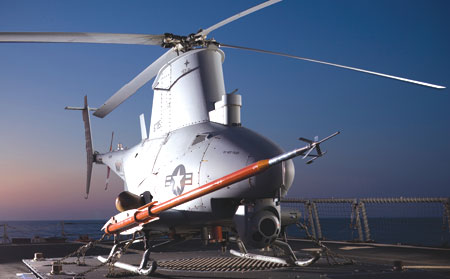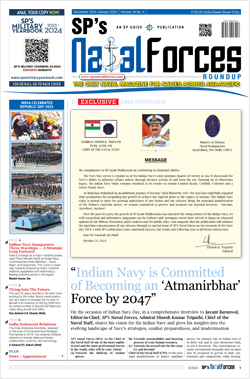INDIAN ARMED FORCES CHIEFS ON OUR RELENTLESS AND FOCUSED PUBLISHING EFFORTS

The insightful articles, inspiring narrations and analytical perspectives presented by the Editorial Team, establish an alluring connect with the reader. My compliments and best wishes to SP Guide Publications.

"Over the past 60 years, the growth of SP Guide Publications has mirrored the rising stature of Indian Navy. Its well-researched and informative magazines on Defence and Aerospace sector have served to shape an educated opinion of our military personnel, policy makers and the public alike. I wish SP's Publication team continued success, fair winds and following seas in all future endeavour!"

Since, its inception in 1964, SP Guide Publications has consistently demonstrated commitment to high-quality journalism in the aerospace and defence sectors, earning a well-deserved reputation as Asia's largest media house in this domain. I wish SP Guide Publications continued success in its pursuit of excellence.
- MoD initiates comprehensive review of Defence Acquisition Procedure 2020, pushes for defence reforms
- G7: The Swansong
- Kalinga Connect: South Asia to Polynesia
- Advanced MRSAM for India for a greater firepower
- Must Credit DRDO for Operation Sindoor, now what is next for defence R&D?
- Operation Sindoor | Day 2 DGMOs Briefing
- Operation Sindoor: Resolute yet Restrained
Operations
Spotlight on UAVs

With advances in computing technology and artificial intelligence, the level of autonomy possible with UAVs will continue to increase, permitting further reductions in training, manning and support requirements
Unmanned aerial vehicles (UAVs) have been around for a very long time. In the 19th century, balloons and kites were used to carry ordnance and cameras to support military operations. Although the UAV technology saw sporadic development throughout the 20th century, it wasn’t until the last decade of the century that UAVs earned due recognition and, consequently, a permanent place in the military arsenal. This occurred as a conse-quence of the significant contribution made by UAVs, such as the Predator, Hunter and Pioneer in the Gulf Wars, Kosovo, Bosnia, Iraq and Afghanistan. UAVs today fulfill the require-ments of a large number of roles earlier the preserve of manned aircraft. They undertake reconnaissance, surveillance, intelligence and, of late, even weapon delivery.
The UAV has emerged as one of the most important military developments of the 20th century. It combines the advantages of aerial platforms, such as speed, flexibility and reach, with those of unmanned platforms, such as lower cost and higher risk employability, afford-ing the military commander unprecedented operational flexibility. Imbued with a host of capabilities, the UAV possesses that make it ideally suited for military operations. Its endur-ance is significantly greater than manned aerial platforms both as a result of the absence of the limiting human factor and incorpora-tion of high endurance aerodynamic designs. In addition to the benefit of lower initial cost, even the operating cost of UAVs is significantly lower than that of a manned aircraft largely as a result of reduced support requirements. Greater risk can be accepted in its employ-ment as a consequence of it being unmanned and due to lower costs. With advances in com-puting technology and artificial intelligence, the level of autonomy possible with UAVs will continue to increase, permitting further reduc-tions in training, manning and support require-ments. UAVs can operate at heights greater than 50,000 ft for sustained durations with attendant operational benefits, something that manned aircraft were unable to do as a conse-quence of human limitations. Their ability to be remotely controlled and operated, separated by thousands of miles from the operational location, permits their forward deployment with minimal logistic support. They can also be operated in ‘dirty’ (nuclear contaminated) envi-ronments with greater ease than manned plat-forms as they can be tightly sealed and would not require to be opened for decontamination of the cockpit whilst changing crew.
Employment in the Navy
Navies of the world have taken note of the capabilities and utility of UAVs in the naval environment. Considering the strengths of this platform, these are being inducted to for roles in intelligence-surveillance-reconnaissance (ISR), targeting, strike and combat support whilst operating from land and naval platforms.
Surveillance and Reconnaissance: With the increasing use of the medium of sea for trade and travel there has been a significant increase in maritime traffic which has, in turn, triggered the need for maritime surveillance in terms of areas to be kept under surveillance as well as greater ‘persistence’ to mitigate secu-rity risks. There is, therefore, a need to monitor all traffic, varying from combat fleets during all out war, to small boats as were used for the 26/11 Mumbai terror attack. Advances in sensor technologies to provide high resolution images with reduced sensor size and weight have enabled UAVs to emerge as the platform of choice for conducting maritime surveillance.
The US Navy proposes to utilise the Global Hawk, from General Atomics of US, as part of the Broad Area Maritime Surveillance Project for maritime reconnaissance (MR) duties. The German Navy is replacing its Atlantique MR aircraft with the Euro Hawk, a derivative of the Global Hawk. The Israeli Navy is also considering replacement of the IAI Westwind MR aircraft with the IAI Heron. In addition to utilising long-endurance shore-based UAVs for surveillance, there is a need to have organic UAV surveillance capability on naval ships. This has been addressed by developing rotary UAVs equipped with surveil-lance and classification sensors. A number of such programmes are currently underway, notable amongst these being the Fire Scout of Northrop Grumman, Orca or EADS, NRUAV of IAI-HAL, Hummingbird of Boeing, Camcopter of Scheibel and Eagle Eye of Bell. These UAVs have longer endurance than manned helicopters; which, in case of the Boeing Hummingbird, is in excess of 24 hours, rival-ling that achieved by fixed wing UAVs.
Intelligence: Historically, intelligence gathering aerial platforms have always had to operate at a distance from their intended intelligence sources for fear of retribution. As a conse-quence of the much improved anti-aircraft systems available today, current intelligence gathering aircraft prefer to stay over own areas whilst executing their missions. This limitation has resulted in a reduction in their capability to intercept low strength signals or gain intelli-gence inputs available only close to the source. This scenario is changing with the introduction of UAVs to perform such duties. UAVs are able to penetrate deeper and therefore closer to the intended targets both because of their incon-spicuousness as well as acceptance of greater risk in their employment.
Offensive Operations: Buoyed by the experi-ence gained during UAV operations in the recent past, UAV manufacturers have moved onto developing larger platforms which have increased payload and therefore the capacity to accommodate both sensors and weapons. A beginning in weaponising the UAV was made with the arming of the Predator with the light (50 kg) Hellfire missiles, a combination that has worked wonders in both Iraq and Afghanistan. To garner greater gains from this development, General Atomics has transitioned from the 1 tonne MQ-1 Predator to the 5 tonne MQ-9 Reaper, IAI has developed the Heron TP in the 5 tonne class and BAES has commenced development of the 6 tonne Mantis. Each of the above platforms will have the ability to carry in excess of 1 tonne of ordnance in addition to sensor payloads. Another notable develop-ment on the ‘combat’ UAV front is that of jet propelled Unmanned Combat Air Vehicles which would, in the not-too-distant-future, offer offensive capabilities similar to manned fight-ers. A number of such programmes are cur-rently underway to produce stealthy offensive platforms in the max all up weight category of up to 20 tonnes. Some notable programmes are the Northrop Grumman X-47B or UCAS-D for the US Navy, which will be carrier borne, General Atomics Avenger, BAES Taranis, Dassault nEUROn and MiG Skat.





